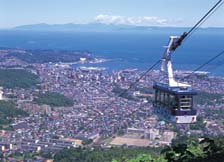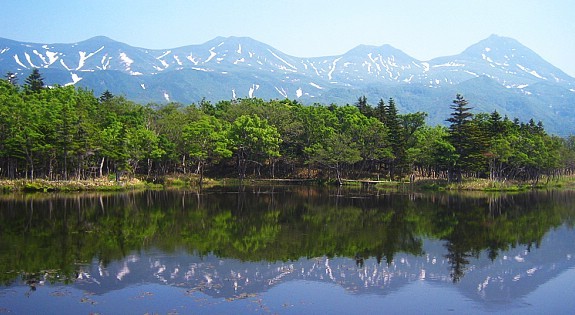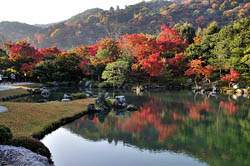Mt. Aso, which is located approximately 30 miles just north of Kumamoto City, is one of the symbols of the Kumamoto Prefecture, once known as Hi no Kuni or the Land of Fire.
Kinwashi Tour Japan Thread
-
TOKYO
Modern Tokyo has arisen from the ashes left after the bombing of WW2. Tokyo is a unique Japanese version of a 21st Century city. Modernistic skyscrapers cast shadows over ancient temples. Traditional small shops, in narrow back streets, stand near to major department stores whose windows display world famous designer goods Ginza, Tokyo.
Ginza, Tokyo.
Among this blend of the new with the ancient there are many places of interest. Among them are:
THE IMPERIAL PALACE. Seated in the heart of Tokyo this immense moated castle is the home of the rarely seen Royal Family. The massive castle walls and the water filled moats are as impressive as they were in the days of the Shogun. The Imperial Palace East Garden is immaculately kept and is open to the public.
The KABUKI THEATER is home to this uniquely Japanese art form. Gorgeous costumes and elaborate settings make the performances memorable even though the ancient dialogue cannot be understood even by many Japanese.
ASAKUSA KANNON TEMPLE One of the oldest temples in Tokyo famed as the home of its rarely seen Golden Goddess to whom millions of Japanese come to pray. The long street of shops leading to the Temple is the Nakamise Dori where an incredible range of tourist souvenirs and Japanese arts and crafts can be found.
HARAJUKU is the fashion district for young Japanese. It is best visited on a Sunday afternoon when the nearby Yoyogi Koen Park is closed to traffic. Young Japanese display their subcultures here. They perform everything from avant garde theatre to hard rock and punk music. To see the often weird costumes worn by youth in revolt against their ordered society is reason enough for the visit. Nearby is the Meiji Shrine to the Emperor who led Japan into the modern world.
ROPPONGI is the playground of the rich. By night it becomes the glittering disco capital of Tokyo with many noisy bars and restaurants. Tokyo Tower is nearby but is a much overrated tourist trap.
GINZA is the area with the designer label shops and designer label prices. It is the most expensive shopping area in Tokyo. It is worth a visit to stroll past the shop windows and gasp at the prices.
AKIHABARA is the famed "Electric City" where every imaginable electrical device is on display. Multi-storied department stores sell only electrical goods which get cheaper as the distance from the railway station increases. Many new electrical products not released overseas can be found here.
TSUKIJI FISH MARKET is the largest fish market in the world.Fish from every ocean in the world are sold here including some varieties not sold in other countries. It is worth a visit to see the distribution system which delivers fresh fish every day to thousands of restaurants not only in Tokyo but all over Japan.
TOKYO DISNEYLAND. If you have never been to a Disneyland this one is the most popular in the world and worth a visit. It is a near perfect replica of the Anaheim California original's rides, slides and shows
UENO PARK contains many museums and art galleries. It is famous for its cherry blossoms in April when thousands of trees burst into colour making an unforgettable display Nearby is the Ameyoko-cho Arcade a very long shopping street market selling every kind of merchandise
SHINJUKU is the commercial centre of Tokyo with skyscrapers competing for space as they dominate the skyline. Many major international companies have their headquarters here. Among the highest buildings is the Metropolitan Government Office Building. From the 45th floor there is one of the best (and free) views of the City of Tokyo. On a clear day Mount Fuji can be seen. -
KYOTO
Capital of Japan for a thousand years,Kyoto is a city of countless magnificent temples. It is still the religious and cultural centre of Japan. Every visitor to Japan should visit Kyoto.Golden Pavilion (Kinkakuji), Kyoto
Among the many temples some of the most famous are :
KINKAKUJI ( The Golden Temple ) Completely covered with gold leaf and situated on the edge of a garden enclosed lake, this temple is so beautiful it is one of the most visited and photographed of all the Kyoto temples.
GINKAKUJI Known as The Silver Temple, even though it was never covered with silver as originally planned,it is famed for its manicured gardens and walkways
SANJUSANGENDO First built in 1164 it houses a thousand life-size multi armed images of Buddha grouped about a huge central Buddha all guarded by 28 fierce warrior statues. A famous archery festival is held here each year in January
KIYOMIZU DERA First built in 789 has a huge verandah supported on hundreds of pillars from where there is a splendid view over magnificent gardens to Kyoto. Visitors can drink from the sacred waters from the temple waterfall.
RYOANJI The most photographed raked sand and rock garden in Japan. Six hundred years ago a garden was created with 15 rocks being placed In a sea of sand enclosed by an earthen wall. The visitor is left to meditate on their meaning. For centuries people have been fascinated by this garden and have sat in quiet contemplation of its simple beauty
The PHILOSOPHER'S WALK follows a traffic free path along a canal past many traditional houses and gardens. While beautiful in any season it is most spectacular in April when the cherry trees which line the walk are in full bloom
GION This district is lined with 17th century traditional tea houses and restaurants many of which are exclusively reserved for geisha entertainment. In the early evening geishas and their apprentices can often be seen dressed in full traditional kimonos hurrying on their way to appointments -
source

Otaru Canal
Otaru Canal used to be a central part of the city's busy harbor in the first half of the 20th century. The canal makes for a pleasant scroll during the day, when various artists present their works to the passing tourists, and it is very romantic in the evening, when the gas lamps are lit.
Hokkaido Prefectural Office
The Former Hokkaido Government Building, nicknamed Akarenga or “redbrick,” was constructed in 1888 in the Neo-Baroque style. It is an exemplar of Meiji architecture and the forecourt is now like an oasis for visitors.
Tenguyama Ropeway
The 30-person gondola carries visitors between the mountain top station and the mountain hill station in just 4 minutes. This ropeway was rated one-star on the Michelin's traveler's guide. Please Enjoy the panoramic view of Otaru Port and Ishikari Bay! -
-
-
Source

So you know where is this picture taken?
Another very famous destination yet to venture.
-
-
So the above picture,
this is the most scenic from Hokkaido.
World Nature Heritage
-
-
Kyoto Arashiyama.

Arashiyama Togetsukyo Bridge
"Moon Crossing Bridge" is Arashiyama's landmark, originally built during the Heian Period (794-1185). Worth watching the combination with the colorful forest in the background.
Tenryu Temple
Founded in 1339 at the beginning of the Muromachi Period (1338-1573), the temple is one of Kyoto's UNESCO World Heritage Sites. In addition to its temple buildings, there are attractive gardens with full of foliage.
Sagano Bamboo Groves
The walking paths that cut through the bamboo groves make for a nice walk. Particularly attractive when there is a light wind and the tall bamboo stalks sway gently back and forth. -
-
-
-
Another interesting Summer event from Japan...
What is this?
Chagu-chagu-umakko
-
Chagu-chagu-umakko. from... Iwate.
something similar over here,
take a look.
What is similar....http://youtu.be/PXbLBvf1Ozg
-
-
-
-
-
-
source.
HIROSHIMA.
HIROSHIMA
Totally destroyed by the Atomic bomb the city has been completely rebuilt and is now a modern and thriving metropolis built around a memorial Peace Park which is a permanent reminder of the horror of the Atomic blast. Atomic (A) Bomb Dome, Hiroshima
Atomic (A) Bomb Dome, Hiroshima
THE PEACE PARK A visit to this park is a must for every visitor to Japan. The A Bomb Dome is left as it was immediately after the atom blast. Its twisted ruins will be left for all time as a reminder of the explosion. The A Bomb Museum contains graphic exhibits showing Hiroshima before and after the blast. A filmed presentation on giant screens shows the attack from cameras on the American planes. Hiroshima is dedicated to preventing the use of atomic weapons for all time
HIROSHIMA CASTLE was originally built in 1589 and rebuilt after being destroyed by the A Bomb. It is not one of the notable Japanese castles but it has many interesting displays using 3D laser techniques
MIYAJIMA ISLAND is a short train and ferry ride from Hiroshima. It is one of the three most beautiful islands of Japan. From the top of Mount Misen, the highest point of the island , there is a breathtaking view over the Inland Sea of Japan to the Japanese mainland. In Autumn and Spring the island is famous for the colours of the maple and cherry trees which grow wild on the island. Tame deer wander all year among the visitors -
Folks
August 12 to 19,
I, will be heading to Japan.
Summertime.
Could be doing self drive, with seven of my kakis.
We are planing to do in two cars, each with four.
We may rent those Kcar about 100 sing dollars per day.
-
10 reasons to visit Japan this summer
Jun 06, 2011 Kyoto geisha beer garden / Image via logspot.com
Kyoto geisha beer garden / Image via logspot.com
Most of Japan is back to normal following the Great East Japan Earthquake and Tsunami on 11 March. Many parts of Japan, including popular holiday destinations such as Hokkaido, Osaka, Kyoto, Nara, Hiroshima, Mt. Fuji, Nagasaki and Okinawa, incurred no disruption to infrastructure and everything in these areas has continuously operated as normal.
Tokyo is back to normal with trains once again running like clockwork, water safe to drink and the beer and yogurt shortages now over (yes, there were temporary shortages due to packaging factories having been in the earthquake-hit region!).
The FCO has said it is safe to travel to Tokyo and beyond in Japan since 5th April, yet UK visitors to Japan have dropped by around 50%. With the full reopening of the Tohoku bullet train line on 29 April, the situation for visitors is virtually back to normal in all of Japan, including most of the Tohoku Region (the area in northeast Japan where the earthquake and tsunami occurred).
Japan is a fantastic destination for a truly memorable holiday and many people in the country rely on tourism for their livelihoods. Here we give you just 10 of the many great reasons to holiday in Japan this summer.
1. Discounted hotel rates – the big drop in visitors following the earthquake has lead to many hotels dropping their rates and launching attractive promotions. For all the latest offers follow Japan National Tourism Organization on Twitter ( @experiencejapan) or see the latest offers page on their website,www.seejapan.co.uk.
2. Help Japan through volunteering - InsideJapan Tours has a 4 day 'Volunteer for Japan' package which enables non-Japanese speakers to get up to Tohoku to assist in cleaning-up and rebuilding. This can be done on its own or added into any self guided/tailored itinerary.
3. Geisha beer gardens – From July until early September, visitors to Japan’s ancient capital of Kyoto can kick back and relax in the company of geisha at a number of beer gardens. An evening with a geisha is usually a pricey luxury, but in a beer garden all it costs is the price of a few drinks and snacks.
4. Hiking – Japan is famous for its bustling modern cities - but it's also home to some of the world's most stunning areas of natural beauty. Oxalis Adventures offer holidays combining the best of Japan's cultural destinations with off-the-beaten-track walking or hiking. From village-to-village walking along the Kiso Valley or hiking the volcanoes of Kyushu, travellers can experience Japan’s nature up-close. Walking in Japan is made all the more enjoyable by the abundance of natural hot springs and the freshest Japanese food, beautifully prepared by your hosts. For more see www.oxalis-adventures.com.
5. Bullet trains – 2011 is an exciting year in Japan for train enthusiasts. The final section of track linking Japan’s bullet train network from the southern tip of Kagoshima to Aomori in the north opened in March. Also in March, the new Hayabusa E5 shinkansen – Japan’s fastest bullet train to date – launched on the Tohoku region route. Services were temporarily suspended after the quake, but the full line has been back up and running since 29 April. Visitors to Japan can enjoy unlimited journeys on the trains using the money-saving 7, 14 or 21 day Japan Rail Pass.
6. BA now flies to Haneda Airport – British Airways resumed its new London to Tokyo Haneda Airport service on 30 May, after temporarily suspending the service following the earthquake. BA is the only airline that offers direct flights from London to Tokyo’s central Haneda Airport. The airport is located within Tokyo, and it only takes 19 minutes by train to get to the city centre. To find out more about BA’s services to Tokyo’s Narita and Haneda airports, visit ba.com.
7. Beaches – Visiting Japan doesn’t have to mean giving up your summer beach holiday. The 160 islands of Japan’s Okinawa Prefecture boast a subtropical climate, coral reefs, emerald seas and sunny skies. Its rich cultural heritage differs markedly from that found in mainland Japan. For those without the time to travel that far, great beaches can be found just an hour-and-a-half by train south of Tokyo on the Izu Peninsula.
8. Relaxed locals – Summer is when you’ll find the locals at their most laid back. Like London, people take time off, work shorter hours and celebrate the warm weather in beer gardens. This summer workplaces in Japan are introducing “Super Cool Biz” relaxed dress codes to decrease the need for air conditioning. So this summer, more than ever, Tokyo will be in relaxation mode.
9. Festivals – Every town, village and city has at least one festival a year. In summer you can choose from music, firework and more traditional cultural festivals. Some of the top ones are:
* Fuji Rock Festival (29-31 July) – this year’s line-up includes Glasvegas, Coldplay, Arctic Monkeys, Beach House, CSS, Warpaint and Mogwai);
* Summer Sonic (13-14 August) this year featuring Jessie J, Yelle, Ne-Yo, Friendly Fires, Tinie Tempah, The Strokes, Beady Eye and the Village People).* Tokyo’s Sumidagawa Fireworks Festival (27 August) – unlike fireworks displays in most other parts of the world, many in Japan are a competition held between rival pyrotechnic groups. Each group tries to out-do the last, and the result is an incredible variety of fireworks, not just in different colours and patterns, but forming shapes as complicated as characters from Japanese animation or kanji.
* Kanto Matsuri, Akita – A spectacular festival featuring young men balancing huge 60kg lantern poles on their shoulders, foreheads, hips or hands.
10. Climb Mt. Fuji – This 3,776 metre high dormant volcano is world-famous as a symbol of Japan. July and August is the official climbing season. During these two months the mountain is usually free of snow, the weather is relatively mild, access by public transportation is easy and the mountain huts are open. To enjoy Mt. Fuji at a more leisurely pace, the best thing to do is spend a night in a ryokan in Hakone or the Fuji Five Lakes area and enjoy its splendid views from a rotenburo (outdoor hot spring spa).
-
-
My good friend Suzuki chan will be the convoy leader,
without local how can we cover those area.

Cars with under 1000cc engine capacity have yellow number plates and are called K-cars in Japan
Car Rental Costs in Japan
Car rental prices in Japan are similar for all the major companies. Typically a 1000c-1300cc compact car such as a Honda Fit, Toyota Vitz, Mazda Demio or Nissan March will cost in the range of 5,000-6,000 yen per day. K-cars, vehicles with less than 1000cc engine capacity and a yellow as opposed to a white number plate, are cheaper. Larger saloon models, 4x4 land cruisers and vans are more expensive.
Car rental costs include basic third party insurance and a charge of around 1,000+ yen per day will reduce your deductible costs in case of an accident to property or the rental vehicle itself from around 50,000 yen to 20,000 yen.
Japan Rental Car Facts
Most rental cars come with a satellite navigation system (GPS), radio and CD player built in. Ask your car company to show you how to use it and maybe enter the telephone number of your destination hotel or ryokan before you set off.
Rental cars come with a full tank and the car should be returned with a full tank. The word for full tank in Japanese is mantan (満タン).
The majority of rental cars in Japan are now no-smoking. Some companies offer an ETC unit in the vehicle to automatically charge you as you pass through Expressway toll gates, though you will need to supply your own ETC card. Child seats are available on request as well as ski carriers and roof racks.
A credit card is normally necessary to rent a car in Japan.
Japan drives on the LEFT with the steering wheel on the right.
Read more: http://www.japanvisitor.com/index.php?cID=443&pID=2483#ixzz1xaENEG3d




